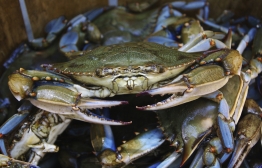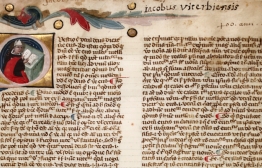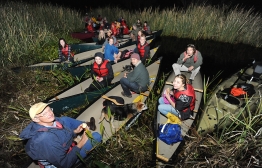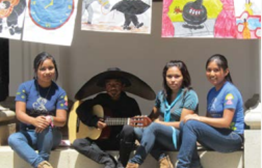As a Loyola student, you have the opportunity to work alongside our talented professors to partner in collaborative research. Learn more about some recent research and projects currently underway.
United Nations Environment Programme Environmental Effects Assessment Panel
Biological Sciences Professor Paul Barnes joined an elite team of scientists from around the world on the United Nations Environment Programme’s Environmental Effects Assessment Panel to investigate the latest effects of stratospheric ozone depletion, which will culminate in a report published once every four years. In Feb. 23-March 3, 2014 the committee met in Cuernavaca, Mexico, to detail how additional UV rays seeping through the Earth’s atmosphere affect human health, manufactured materials, ecological systems, climate change and other areas. The group will meet again this August in Zhengzhou, China. Barnes’ contribution to the international research effort focuses on what happens to plants and ecosystems under the diminished ozone layer. Ozone depletion and the resulting increased UV could affect things like how fast dead plant material decomposes—ultimately affecting the availability of vital nutrients for plants and soil. Plants exposed to more of the sun’s harmful rays also react by adding more “sunscreen” chemicals to their leaves for protection, according to Barnes. Those consequences have a complicated domino effect on the entire ecosystem, disruptively flowing through the entire food chain. For example, when plants change chemically for sun protection, it can affect the herbivores that eat the plants, according to Barnes. Barnes also lent his expertise to the European Union March 30 in Bled, Slovenia. He acted as an outside evaluator, providing feedback on UV and climate change research funded by the EU. Barnes will work with the European Cooperation in Science and Technology, which coordinates nationally funded research for Europe.
Relevant web sites:
http://ozone.unep.org/new_site/en/assessment_panels_bodies.php?committee_id=8
http://www.cost.eu/
Associated publications and presentations by Dr. Barnes include:
Barnes, P.W., H.L. Throop, S.R. Archer, D. D. Breshears, R.L. McCulley, and M.A. Tobler. 2014. Sunlight and soil-litter mixing: drivers of litter decomposition in drylands. Progress in Botany (In Press).
Wargent, J.J., B.C.W. Nelson, T.K. McGhie, and P.W. Barnes. 2014. Acclimation to UV-B radiation and visible light in Lactuca sativa involves up regulation of photosynthetic performance and orchestration of metabolome-wide responses. Plant, Cell & Environment (In Press).
Barnes, P.W., A.R. Kersting, S.D. Flint, W. Beyschlag, and R.J. Ryel. 2013. Adjustments in epidermal UV-transmittance in sun-shade transitions. Physiologia Plantarum 149: 200-213. DOI: 10.1111/ppl.12025.
Barnes, P.W., M.A. Tobler, A.E. Barkley, S.D. Flint, R.J. Ryel, K.M. Keefover-Ring, R.L. Lindroth. 2014. Rapid changes in UV-shielding in plants: mechanisms, species patterns and physiological significance. European Union COST Action UV4growth Final Meeting, Bled, Slovenia. (Invited Presentation) A.E. Barkley was an Environmental Studies Minor.
Levi, E.M., S.R. Archer, H.L. Throop, K.I. Predick, P.W. Barnes, and M.A. Tobler. 2013. Soil deposition and UV radiation influence litter decomposition in a shrub-invaded dryland ecosystem. RISE Conference, Tucson, AZ (poster).
Barnes, Paul. W., Mark A Tobler, Stephan D. Flint, Ronald J. Ryel, Kenneth Keefover-Ring, and Richard L. Lindroth. 2013. Diurnal changes in leaf UV-absorbing compounds and epidermal UV-transmittance. Ecological Society of America, Minneapolis, MN, August 2013. Oral presentation.
Blue crab larvae into the Lake Pontchartrain estuary
Mallory Hirschler (ENVB major) was awarded a Louisiana Board of Regents S.U.R.E. grant which allows her to work under faculty mentorship of Professor Frank Jordan (Biological Sciences) to conduct a study of recruitment of blue crab larvae into the Lake Pontchartrain estuary. A goal of the Louisiana Experimental Program to Stimulate Competitive Research (LAEPSCoR) project, funded by the National Science Foundation (NSF), is to increase the participation of women and other underrepresented minorities and in STEM (Science, Technology, Engineering, and Mathematics) fields. The Supervised Undergraduate Research Experiences (SURE) program seeks to further this goal by fostering opportunities for such students to conduct supervised research with a faculty mentor.
Metaphysical thought of the late thirteenth century philosopher-theologian James of Viterbo
Prof. Mark Gossiaux is working to produce a book-length study of the metaphysical thought of the late thirteenth century philosopher-theologian James of Viterbo. Since only some of James’ writings are available in a critical edition, Dr. Gossiaux must make use of fourteenth century manuscripts to recover the unedited parts of James’ works. These manuscripts, written in a highly abbreviated Latin, require careful and meticulous study if their secrets are to be revealed. Dr. Gossiaux’s book, which aims to provide a complete historical reconstruction of James’ metaphysics, will make an important contribution to the scholarly understanding of late medieval philosophy.
Wetlands loss and the human impact on the landscape
When biology professor David White, Ph.D., takes his students into the swamp, he likes to go after dark. The wetlands south of New Orleans that he leads his classes through in canoes are full of snakes, spiders, and insects, and he will periodically tell students where to point their flashlights so they can reflect constellations of red alligator eyes.
He is not trying to scare anyone, he said, but to “demystify that nighttime world.” He likes to remind students that the drive down the interstate to the launching point is far more dangerous than slowly skimming in the dark through the reeds. He wants them to feel comfortable in the outdoors, and he uses the experience as a way to break down misconceptions about the natural world they study in biology class.
As they paddle, White discusses topics on ecology while natural manifestations of what he describes abound around them. The trips also provide students the emotional and spiritual sensations involved in being outdoors, which, White said, fewer and fewer of his incoming students have experienced.
The expeditions provide his students common points of reference that enrich classroom discussions. One honors student wrote to White and said she wished the trip had taken place earlier in the semester, because it was such an enriching bonding experience. The subjects his students study—like wetland loss, human impact on the landscape, and the interaction of organisms and their environment—become at once more tangible and complex, and his students come away with a more nuanced understanding and sincere appreciation of the natural world than any classroom lecture could provide them.
Algae Growth on Submerged Human Hair
Ask The Algae: A biology student and her mentor devise a novel way to determine how long corpses have been underwater to aid law enforcement efforts.
Anyone who has watched mafia movies knows what a mobster means when he says he is going to make someone "sleep with the fishes." But this method of disposing of evidence on-screen has corollaries in real life, which can present real problems for law enforcement.
Currently, there is no good method to determine how long a body has been underwater. Such knowledge could potentially provide detectives important insight into when a crime was committed.Thanks to a Loyola student's honors thesis project, scientists may be one step closer to solving this conundrum.
Recent graduate Shelly Wu and her faculty mentor, James Wee, Ph.D., provost distinguished professor of biological sciences, monitored the growth of algae on submerged human hair and found its proliferation to be a potentially reliable time marker. For the project, Wu affixed standardized bunches of hair - clipped from her own head - to plastic foam mannequin heads she submerged in a freshwater garden pond and a brackish canal. She collaborated with James L. Pinckney, Ph.D., at the University of South Carolina to complete sophisticated measurements of the amount of Chlorophyll a - found in algae - on the hair, a method that could help investigators determine how long a cadaver has been submersed in water.
Wu documented her findings in a paper she co-authored with Wee and Loyola biology professor Craig Hood, Ph.D., which Wu presented at the 2013 Annual Meeting of the Botanical Society of America. She traveled from the University of Oklahoma, where is continuing her studies of algae ecology as a graduate student, to the 2014 Joint Aquatic Sciences meeting in May 2014 to present a follow-up.
By presenting at a scholarly conference as an undergraduate, Wu said, she gained yet another head start on many of her peers in building the complete set of skills required of a working scientist.
"A large component of being successful in science is presenting your work," Wu said. "It's how you establish yourself in the field, interact with and make an impression on experts. As an undergraduate, it was an enriching experience."
The experience Wu gained at Loyola put her ahead of many of her colleagues in graduate school - some, she said, have never conducted any independent research. As is true for many young Loyola researchers, the hands-on learning she engaged in here made a huge difference.
"It got me in the door," she said. "I was accepted to all of the graduate programs I applied for. If it wasn't for undergraduate research, I probably wouldn't be here."
Guatemalan author and activist Luis de Lión
In Luis' Footsteps: A museum memorializing a "disappeared" Guatemalan author and activist receives translation assistance from Loyola students
Nathan Henne, Ph.D., associate professor of languages and cultures, has been studying the life and work of Guatemalan author and activist Luis de Lión for eight years. In 2012, the University of Arizona Press published for the first time in English de Lión's most important work, Time Commences in Xibalbá, which Henne translated and introduced.
Henne's research uses de Lión as a prism to examine broader themes of ethnicity, identity, imperialism, and violence. For the past two years, Henne's students have joined the professor in this exploration, which has taken them to the sites of mass graves and museums, and to an understanding of the values for which Luis de Lión lived and died.
Henne's students Taylor Adams and Molly Wagner took lengthy trips through Guatemala during their summer breaks to lay the groundwork for their research projects.
"A lot of de Lión's fiction is concerned with how difficult it is to build a nation state around a nation's - supposedly singular - identity, but still leave room for real difference among the many indigenous groups," Henne said, "especially when that country went through an extended colonial period where racial difference was the most significant ordering principle. That's why it was so important for Molly and Taylor to travel throughout Guatemala and better understand the legacy of the colonial period."
Wagner, who plans to further her studies in international human rights, accompanied a team of forensic scientists who exhumed mass graves from the period of state-sponsored violence in Guatemala that spanned 1954-1996. Scientists and human rights workers were trying to identify bodies of those "disappeared" by the government during that time - de Lión among them. Adams worked with the Proyecto Luis de Lión, founded and operated by de Lión's daughter Mayari, to create a website for the organization, which includes a museum, library, and arts education center. The website builds awareness about the organization and provides an important avenue through which its administrators can raise money and solicit donated musical instruments.
But perhaps the most important work Adams and Wagner did was translate elements from the Casa Museo Luis de Lión into English. The 15-year-old museum uses the life of de Lión as a starting point to introduce the historical context in which the indigenous author "disappeared," a period of deep racism toward the indigenous and a general intolerance toward creativity, intelligence, and union activism, such that de Lión took part in. Now, thanks to Loyola students' translations, visitors from other countries who speak English but not Spanish can fully realize the complicity of the United States in the atrocities in Guatemala's recent history that claimed the lives of hundreds of thousands of its indigenous inhabitants, such as the author at the core of its existence.





